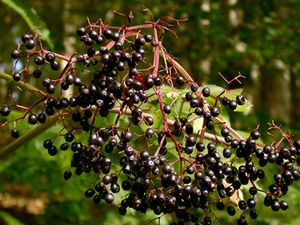Sambucus nigra
| See Also | Botanical Monographs |
|---|
Elder (Sambucus nigra) has traditionally been used to treat many ailments such as coughs, colds, allergies, and arthritis. To explore the characteristics, medicinal uses and prescribing considerations of this herb in more detail, check out the references indicated.[1] [2]
Contents
Characteristics
- Common Names: Elder, Sambucus, Black elder, Common elder, Pipe tree, Bore tree, Bour tree, Hylder, Hylantree, Eldrum, Hollunder, Sureau
- Family: Caprifoliaceae
- Habitat: Sambucus nigra is common place throughout the United Kingdom and Europe but it can now also be found in North America.
- Parts Used: Leaf, berry, bark
- Constituents: Flavonoids, triterpenes, essential oils, sterols, phenolic acids
- Medicinal Actions:
- Flower - diaphoretic, astringent, diuretic, vulnerary
- Berry - antirheumatic, antioxidant, antipyretic, immune enhancing, pectoral
- Bark - purgative, emetic, expectorant,
Uses
Historical Uses:
Sambucus nigra has traditionally been used to treat many ailments such as coughs, colds, allergies, and arthritis. In folklore, it was believed to be a good luck charm that could cast away robbers and kill snakes. Elderberries can also be used as food to make pies or wine.
Medicinal Uses:
- Other Conditions
Prescribing Considerations
The information provided is intended to augment the treatment from a naturopathic doctor or other trained medical professional. Although most herbs are generally safe, it is recommended that you avoid self-prescribing especially when there is an underlying ongoing medical condition, if you are on any prescription medications or if you are pregnant or breastfeeding.
Formulations and Preparation
Internal
- Dried flowers - 3-5g three times daily
- Liquid extract (1:1 in 25% ethanol) - 3-5mL three times daily
- Tincture (1:5 in 25% ethanol) - 10-25mL three times daily
External
- Elder flowers - used as poultices, ointments and salves
Safety
The safety and prescribing considerations for this herb include:[3] [4]
- Generally regarded as safe.
- Side-effects are generally not seen with the berries or the flowers. The cyanogenic glycosides found in other parts of the plant may cause gastrointestinal upset (nausea, diarrhea, and vomiting).[1]
- Cautions and Contraindications: Pregnancy and Lactation, hypokalemic (low potassium) potential (prolonged use not recommended), limit products made from ripe berries or flowers only
- Drug-Herb Interactions are not noted.
References
- ↑ 1.0 1.1 Boon Heather, Smith Michael (2009) 55 Most Common Medicinal Herbs: The Complete Natural Medicine GuideSecond Edition Institute of Naturopathic Education and Research, CCNM Toronto.
- ↑ Godfrey Anthony, Saunders Paul, Barlow Kerry, Gowan Matt (2011) Principles and Practices of Naturopathic Botanical Medicine, Advanced Botanical Medicine. V3 CCNM Press, Toronto.
- ↑ Stargrove Mitchell Bebell, Treasure Jonathan, McKee Dwight L (2008) Herb, Nutrient and Drug Interactions: Clinical Implications and Therapeutic Strategies.
- ↑ Brinker Francis (1997) Herbal Contraindications and Drug Interactions: Plus Herbal Adjuncts With Medicines, 4th Edition Eclectic Medical Publications.
